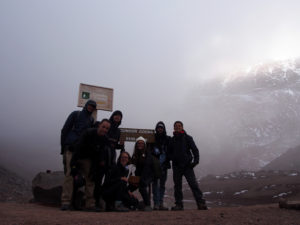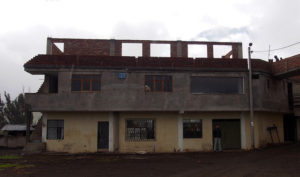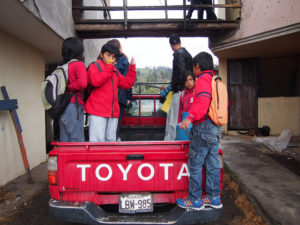For two and a half weeks in July 2016, I worked as a volunteer teacher during Summer School at a community school in rural Ecuador. Escuela Katitawa can be found in the small town of Salasaka, approximately three hours by bus from Quito.
Salasaca
Salasaca is a really tiny town. It has one main street and the other few streets are residential. There are a few small stores, an ice creamery, a bar and a very small souvenir market.The locals are incredibly friendly and welcoming.
If you ever need to grocery shop, get laundry done or complete any other similar chores, then the neighbouring town of Pelileo is the place to go (a 25c bus ride down the road).
Day-to-Day Volunteering at Escuela Katitawa
The Volunteers
The school and library are primarily staffed by overseas volunteers, of which I was one. During my time at Escuela Katitawa my fellow volunteers included some men from the U.S.A, Italy, France, two women from Great Britain, a couple from Italy and a couple from Belgium. For the last twelve years an older gentleman from the U.S.A. has run the school.
 The volunteers live together in a volunteer house and do everything together, eat, work, play games in free time. During the weekends there is nothing to do in Salasaka so the volunteers often go on a group adventure to nearby areas for hiking and other fun adventures. On one occasion nine of us hiked an inactive volcano, Chimborazo, to 5100 metres; before heading to the adventure capital of Ecuador, Baños to jump off the bridge in a bridge swing (puenting) and soak in the thermal pools.
The volunteers live together in a volunteer house and do everything together, eat, work, play games in free time. During the weekends there is nothing to do in Salasaka so the volunteers often go on a group adventure to nearby areas for hiking and other fun adventures. On one occasion nine of us hiked an inactive volcano, Chimborazo, to 5100 metres; before heading to the adventure capital of Ecuador, Baños to jump off the bridge in a bridge swing (puenting) and soak in the thermal pools.
The camaraderie amongst volunteers is what makes the experience worthwhile.
The School
 The school is a 25 minute walk, or a five minute ride on the back of a truck, up the hill from the Volunteer House and Library. The walk can be a little daunting as the dogs from local properties tend to get defensive and bark at you as you walk by; some dogs also chase you. Typically they are all bluff.
The school is a 25 minute walk, or a five minute ride on the back of a truck, up the hill from the Volunteer House and Library. The walk can be a little daunting as the dogs from local properties tend to get defensive and bark at you as you walk by; some dogs also chase you. Typically they are all bluff.
The School has four main classrooms; one office for the Principal; two composting toilets; a yard to play in; an organic garden; and a kitchen and dining hall.
Each of the classrooms have some tables and chairs and a small whiteboard. Unfortunately though the school has no electricity and no heating, so both teachers and students are always rugged up in many layers of warm clothing.
Most, but not all doors lock, which means that overnight many items (including toilet paper) need to be relocated to prevent theft.
The Library
The Volunteer House and Library are two joined buildings that can be found by the roadside a few kilometers from central Salasaka.
Community members may purchase library membership for just a few dollars per year to have access to the books, or they may pay a few dollars per month for internet access.
In addition to functioning as a library, the library building is also used for private tuition lessons. It has two classrooms and one open space where the books and main desk are found.
The Volunteer House
The Volunteer House is both the level above the Library and the building beside it. Several years after construction began, it is still under construction.
 There is a communal kitchen, dining room, living room, wifi zone and bathroom. There are several dorm style bunkrooms. Most rooms have a small ensuite, though some lack doors, functioning sinks or toilets. None of the ensuites have a functioning shower. All volunteers share the bathroom above the library for access to the shower. The shower is the only place in the building where hot water can be found.
There is a communal kitchen, dining room, living room, wifi zone and bathroom. There are several dorm style bunkrooms. Most rooms have a small ensuite, though some lack doors, functioning sinks or toilets. None of the ensuites have a functioning shower. All volunteers share the bathroom above the library for access to the shower. The shower is the only place in the building where hot water can be found.
Several of the windows in the building lack glass, the living room window is a sheet of clear plastic and the kitchen has two holes where windows belong. There is no form of insulation or heating in the building, which once again means that all volunteers are permanently rugged up against the cold.
Laundry can be done either in a cold tub of water by hand, or it can be taken to the neighbouring town of Pelileo where rates are very reasonable.
In my second week we had no water for three days out of four, which creates major issues for cooking, bathing and going to the toilet.
If it weren’t for the amazing people I have worked with, I would not have stayed very long living in these rustic conditions.
It costs $7.50 per day to volunteer with Escuela Katitawa, or $20 per week. The money goes towards the running of the volunteer house (such as food for the volunteers, gas and electricity), school resources and construction materials.
The Daily Schedule
 7:00 Porridge breakfast is prepared for the volunteers
7:00 Porridge breakfast is prepared for the volunteers
7:30 The truck departs for the school, if you miss it, you walk
8:00 The first lesson of the day begins
9:30 Students have a short break, during which time they can buy crisps from the kitchen and play in the yard
10:00 The second lesson of the day begins
11:00 Students have a short five minute break to run around, some students change classes at this point in time eg. The five year olds switch from Mathematics to English
12:00 Lessons finish for the day
12:30 Lunch is provided for the volunteers in the school dining hall. It is typically vegetable soup or rice with vegetables
1:00 Volunteers typically walk back to the volunteer house to hang out, or perhaps travel into Salasaka or Pelilieo to do groceries or laundry
4:00 From 4pm until 8pm, volunteers are assigned hour long private tuition sessions with students. Students range in age from 5 years old through to adults. They may study subjects such as English, French or Mathematics. I suspect tutoring would be provided in any subject requested
8:00 Around 8pm the student are provided with a delicious vegetarian meal prepared by Margarita
Summary of the experience
After a 12 month sabbatical from the classroom I was quite excited about this volunteer teaching opportunity. Overall I felt I was able to help the students a little bit, but generally I found the experience more frustrating and disappointing than anything else.
The living conditions were incredibly rustic and I couldn’t cope with being freezing the whole time, no matter how many layers of clothes I wore.
I really appreciated the opportunity to get to know some of the locals and feel welcomed into their community. I also really enjoyed getting to know and work with other volunteers.
Some aspects of the volunteering program were enjoyable, but if I were to volunteer elsewhere, I would certainly look for a placement that was more effectively organised, with better overall conditions.
It was certainly a memorable experience.
